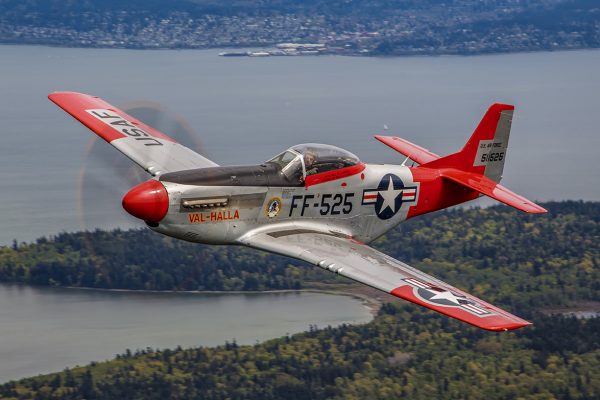
Technical Specifications
- Max Speed: 437 mph
- Cruising Speed: 275 mph
- Range: 1000 miles
- Service Ceiling: 41,900 feet
- Wingspan: 37’ 0”
- Length: 32’ 3”
- Height: 13’8”
- Weight: 12,100 lbs max
Armament
Six .50-caliber machine guns and ten 5-inch rockets
-or-
2,000 lbs. of bombs
Engine
Packard built Rolls Royce 'Merlin' V-1650 of 1,695 hp
General Information
The P-51 was the “100 day wonder” of WWII. Originally specified and ordered by Great Britain and ignored by the US Army Air Corps, the aircraft was designed and built by North American Aviation from the ground up in 100 days. When it’s capabilities were later recognized by the USAAC, it was ordered in vast quantities. The range, speed and high-altitude capabilities enabled the Allied forces to escort bombers far deeper into enemy territory than any other fighter aircraft–as exemplified by the 332 Fighter Group (the Tuskegee Airmen in their “Red Tail” Mustangs). This allowed the continuation and fruition of the American bomber force’s tactic of precision daylight bombing.
Specific Information
Built in 1945, this aircraft served in the Texas Air Guard until it was sold under Lend Lease act to the Indonesian Air Force. Along with one other, it was returned to the US by Stephen Johnson and sold to the War Eagles Museum where it went through initial restoration. It was further restored by Pena Olivas for Bill in 1995. Donated by Bill & Valerie Anders as the founding asset when the Heritage Flight Museum was started in 1996, “Val-Halla” reflects the colors of the 57th FIS, the Black Knights. The Black Knights were based in Keflavik Iceland with the primary mission of Air Defense during the Cold War; this is the squadron Bill flew F-89′s with back in 1958.
This airplane is named ‘Val-Halla’ to honor Bill’s wife and museum co-founder Valerie.
Val-Halla is also Viking heaven, so the name also reflects the fond memories Bill has for the time he spent in Iceland and the year he spent as Ambassador to Norway.
Bill raced this plane at Reno in 1997, ’98 and ’99 as race #68. His race number commemorates 1968, the year Apollo 8 went to the moon. His best showing at the Reno Air Races with this airplane was on a gusty race Sunday in ’97, with Bill applying his bad-weather flying experience to take third in the Unlimited Class Silver race.

